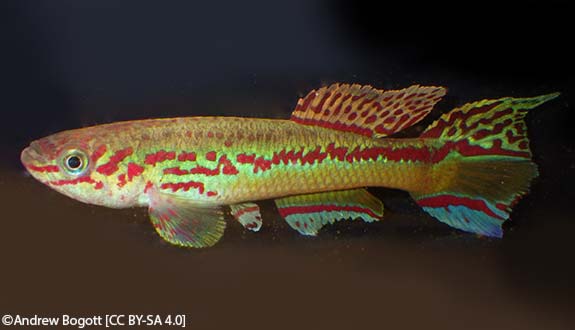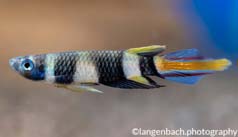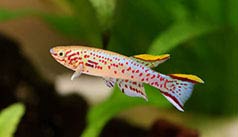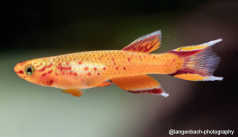

Alternative species (click on the thumbnail to see the card)
Names
Scientific name
Fundulopanchax amieti
Aphyosemion amieti
Common name
Amiets lyretail
Amiet's Lyretail
Amiets Lyretail Killifish
Amiet's Lyretail Panchax Kellifish
Origin

Origin: West Africa, Cameroon
Biotope: African
Dimorphism

Females are much less colourful than males. They are beige / yellow while the males are orange.
Group

Cynolebiidae (Nothobranchiidae)
Volume

30 L / 6 imp gal / 8 US gal
Parameters

T°: 20 to 25°C or 68 to 77°F
pH: 6 to 7
Hardness: 8 to 12°dGH
Difficulty

Easy
Size

7cm (2.8")
Longevity

2 to 3 years
Living zone
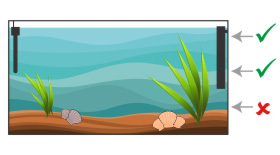
Middle and top
Individuals

3 (harem)
Food
How to feed the Fundulopanchax amieti?
Food
How to feed the Fundulopanchax amieti?
Killies are carnivorous fish. They are not very difficult to feed and will accept a wide range of foods.
In order to guarantee them a better health and a beautiful coloration, vary the menus as much as possible. You can propose (non-exhaustive list): daphnia (red daphnia reinforce the coloration of fish!), tubifex, artemia, mosquito larvae, mud worms, traditional commercial foods... All presentations are accepted: live, frozen or dry prey.
Preferably provide two small meals a day rather than one large one.
Behavior
What kind of behavior does the Fundulopanchax amieti have?
Behavior
What kind of behavior does the Fundulopanchax amieti have?
Pacific and calm, it is quite shy (it can even sometimes seem apathetic if the maintenance conditions do not suit it). An aquarium with lots of hiding places can also calm his fear.
They like to spend time hidden among Java moss (Taxiphyllum barbieri) or Singapore moss (Vesicularia dubyana). These plants give them confidence.
Cohabitation
Who can live with the Fundulopanchax amieti?
Cohabitation
Who can live with the Fundulopanchax amieti?
Because of his shy temperament, a specific aquarium is highly recommended. For this, a nano aquarium of about thirty litres can perfectly suffice for a small group. The basic group consists of one male for every two females.
If you still want to install it in a community aquarium, plan a larger aquarium and don't associate it with fish that are too lively or too active. Instead, use small, quiet fish.
It should never be associated with other species of Killies because of the risk of hybridization (which has the longest history of completely denaturing "pure" strains). If you have hybrids, don't release them in order to preserve the strains.
Breeding
How to breed the Fundulopanchax amieti?
Breeding
How to breed the Fundulopanchax amieti?
The reproduction of this species is not as easy as that of its cousin the Aphyosemion australe but is still feasible. The fish are sexually mature when they reach the age of 6 months. To put all the chances on your side, start with these water parameters: temperature at 20°C (68°F), pH at 7 and hardness at 12°dGH. Install laying supports such as mops or Java moss in the bottom of the aquarium. Finally, stimulate reproduction by feeding large quantities of small live prey. The female lays her eggs on the ground or on a mop.
After laying, retrieve the eggs and place them in a separate small aquarium to facilitate their rearing. Fill this aquarium beforehand with water from the adult tank. On the technical equipment side, it can just have a small sponge filter on an air pump powered booster to ensure the water stirring.
No need for lighting. Another possibility to recover the eggs: isolate 1 male and 2 females in the rearing tank and remove them once the laying is finished.
Incubation takes 6 to 8 weeks depending on the temperature. Maintain darkness during this period.
Fry feeding: artemia nauplia and microworm.
Its aquarium
Which aquarium for the Fundulopanchax amieti?
Its aquarium
Which aquarium for the Fundulopanchax amieti?
In nature, it lives in very crowded environments covered with vegetation. The water there is almost stagnant and of low height.
For an ideal aquarium, reproduce these conditions in your tank :
lots of vegetation
floating plants for dimming the light
lots of roots and stones for a rugged setting
Dark ground covered with dried tree leaves (beech, oak, catappa...)
aged water
not too much current (or not at all)
lid (excellent jumpers, killies can jump out of their aquarium)
lighting: optional
immersion heater: optional
filter: optional.
If you do not put a filter, renew the water regularly (15 to 20% every week) with previously aged water.
To sum up, lighting, filter and immersion heater are not mandatory in the good maintenance of this species. Have you recognized the LowTech technique? It is perfectly adapted to this species!
Good To know
Find all additional information!
Good To know
Find all additional information!
Unfortunately, this species is very threatened in its natural environment because of deforestation.
In the wild, Killies are able to "crawl" from pond to pond, sometimes spending long periods out of the water.
Robust and easy to maintain, this species is perfectly adapted to beginner aquarists.
Beware, Killies do not tolerate hot weather (beware of summer heat waves).
Fundulopanchax amieti owes its name to André Amiet, director of the natural sciences laboratory of the University of Yaoundé in Cameroon.
Yours photos!
Comments
Sort by:
Please login to post comments
